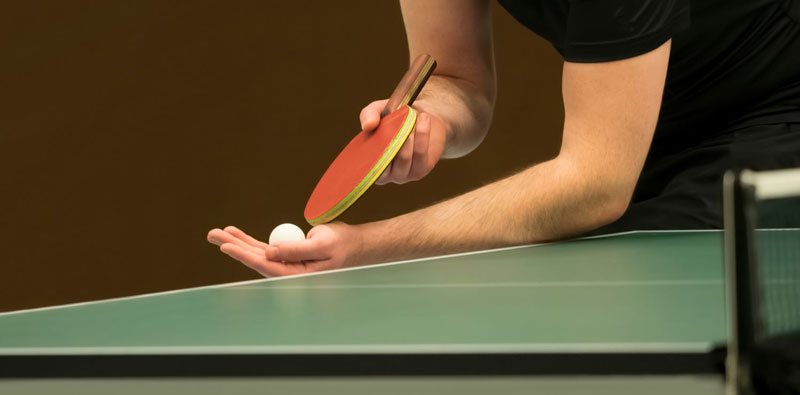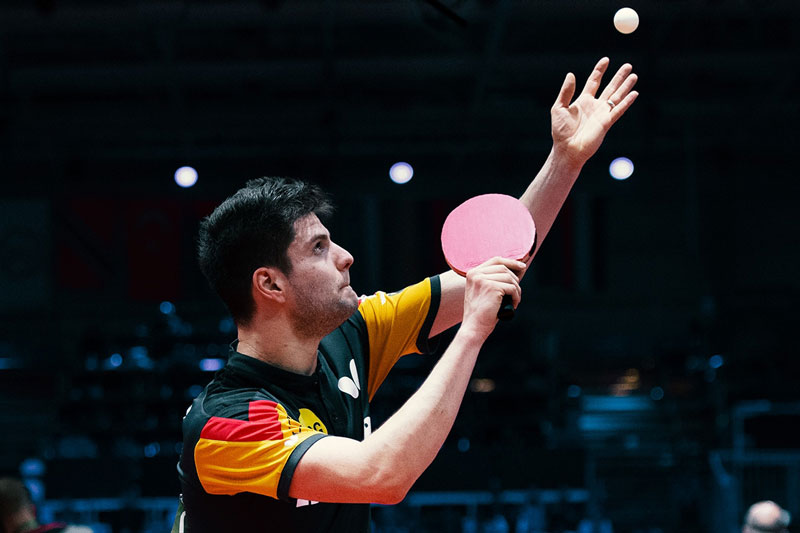What do the official table tennis rules say about a good serve?
Why do the service rules keep changing? Find out here…
Starting your serve
Law (rule) 2.06.01 states that…
"Service shall start with the ball resting freely on the open palm of the server's stationary free hand".

The purpose of this rule is to prevent a player from imparting spin onto the ball (with his fingers or his hand) as he throws it up.
In the 1930s, finger spin serves were very popular and players were able to impart heavy spin onto the ball before they struck it with their racket.
The service rules were therefore amended several times during the 1930s and 1940s in order to prevent these types of service.
However, umpires are now told that they should concentrate on ensuring that the ball is resting freely on the palm of the server’s hand … so that no spin can be imparted as the ball is thrown upwards … rather than be too concerned with the precise curvature of the server’s free hand.
Throwing the ball upwards
Law (rule) 2.06.02 states…
"The server shall then project the ball near vertically upwards, without imparting spin, so that it rises at least 16cm (approx 6 inches) after leaving the palm of the free hand and then falls without touching anything before being struck".

The purpose of this rule is to ensure that the server strikes the ball as it’s falling from the vertical.
Before adding this requirement for the ball to rise by at least 16cm, it was difficult for the umpire to establish whether the ball was being struck on the way up or on the way down.
Also, by requiring the server to throw the ball upwards within a few degrees of the vertical (rather than a previous rule which stated it had to be within an angle of 45°), the umpire can be sure that the ball has been thrown upwards and not sideways or diagonally.
This prevents a player from throwing the ball directly onto his racket, thereby generating extra speed on his serve.
Also, by specifying that the ball must rise at least 16cm (approx 6 inches) from when it leaves your hand … it means you must throw it well clear of your hand. Therefore it’s not a legal serve if you lift the ball up with your hand to shoulder height, then only throw it up less than 16cm.
It’s also worth noting that, as soon as the server has deliberately thrown the ball upwards, the ball is “in play”, so if the server does not make contact with the ball or serves incorrectly, he loses the point.
Strike the ball
Law (rule) 2.06.03 states that…
"As the ball is falling the server shall strike it so that it touches first his court and then touches directly the receiver's court; in doubles, the ball shall touch successively the right half court of server and receiver."
The purpose of this rule is to ensure that the server can’t serve overarm like in tennis. This would potentially make every serve unreturnable!
It also ensures that the ball must be struck as it’s falling and not as it’s rising.
Once your service has hit your side of the table it must pass over (or around) the net and then hit your opponent’s side of the table.
The ball must bounce at least once on your opponent’s side of the table and you can serve from and to, any part of the table.
However, in doubles, the serve must be played diagonally, i.e. within the right half courts only, whereas in singles you can serve from and to, any part of the table.
If your opponent doesn’t hit the ball after it has bounced once, you win the point (unless it touched the net when you served – then you replay the point).
Whilst serving, the official table tennis rules also say that you must keep the ball…
Above the playing surface
Law (rule) 2.06.04 states that…
"From the start of service until it is struck, the ball shall be above the level of the playing surface and behind the server's end line, and it shall not be hidden from the receiver by the server or his or her doubles partner or by anything they wear or carry."

This means that the ball must both be above the level of the playing surface and behind the end line, during your entire service action.
(The end line is regarded as extending indefinitely in both directions).
Other parts of your body (for example your arm and parts of your hand or legs), may be over the playing surface or along the side of the table, but the ball must not.
The main purpose of this rule is to ensure that the ball is visible at all times to your opponent, however … there’s no specific requirement for your opponent to be able to see your racket before you strike the ball, so you could begin your service action with your racket concealed, for example, behind your back or under the table.
No hiding
In 2003 the official table tennis rules were amended to ensure that the receiver can see the ball at all times throughout the service.
Law (rule) 2.06.05 now states that…
"As soon as the ball has been projected, the server's free arm and hand shall be removed from the space between the ball and the net."
The main purpose of this rule is to make sure that the receiver (and the umpire) can see the ball throughout the service action.
This means that the receiver will be able to see the racket as it strikes the ball and therefore the receiver will have a much better chance of reading the spin and, therefore, returning the service.
This rule is an extension of rule 2.06.04 and was introduced to stop players from hiding the contact point of the racket on the ball … because if your opponent can’t see your racket striking the ball, he can’t judge how much spin you’re imparting onto the ball … so his chances of making a good return are significantly diminished.
Two other important rules relating to the serve are…
Taking responsibility for your service
Law (rule) 2.06.06 states that…
"It is the responsibility of the player to serve so that the umpire or the assistant umpire can be satisfied that he or she complies with the requirements of the Laws, and either may decide that a service is incorrect."

This means what it says!
It’s the responsibility of the player to serve so that the correctness of his service action can be seen by the umpire.
If you don’t, you run the risk of being penalised…
Warnings and penalties
Law (rule) 2.06.06.01 also states that…
"If either the umpire or the assistant umpire is not sure about the legality of a service he or she may, on the first occasion in a match, interrupt play and warn the server; but any subsequent service by that player or his or her doubles partner which is not clearly legal shall be considered incorrect."
This means that an umpire who suspects, but isn’t sure, that your service action is illegal, may warn you without awarding a point to your opponent.
However, the umpire will only give you one warning during a match … so if any of your subsequent serves in that match are of doubtful legality, for the same or any other reason … your opponent will be awarded the point.
Whether or not the umpire gives you a formal warning, the umpire can advise you informally, between rallies, that your service may be incorrect and that it may be punished if it doesn’t improve.
But, contrary to popular belief, a player is not entitled to a warning for a first illegal service. A clear failure to meet the requirements of the service law should always be penalised by the umpire awarding a point to your opponent.
However, there is an exception to the above rules for players with a…
Physical disability
Law (rule) 2.06.07 states that…
"Exceptionally, the umpire may relax the requirements for a correct service where he or she is satisfied that compliance is prevented by physical disability."

This means that if a player cannot comply with any part of the service rule due to a physical disability, then the umpire may exercise discretion about what constitutes an acceptable service.
You will see this exception being applied in the Paralympic Games and also in other competitions.
For example, Ibrahim Hamadtou from Egypt has a physical disability but still plays in the top professional events.
As he does not have hands, he cannot serve in accordance with the above rules, so the umpire will exercise discretion and not penalise him for non-compliance with Law (rule) 2.06.01.
